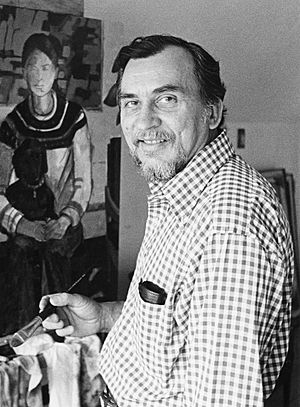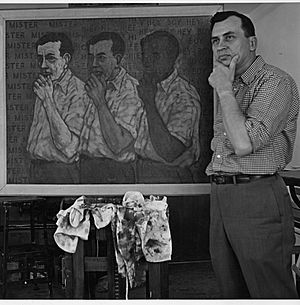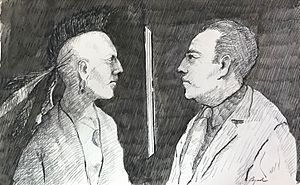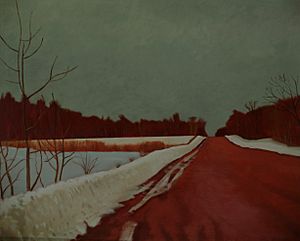Gibson Byrd facts for kids
Quick facts for kids
Gibson Byrd
|
|
|---|---|
 |
|
| Born |
Decatur Gibson Byrd
February 1, 1923 |
| Died | April 16, 2002 (aged 79) |
| Nationality | American |
| Education | University of Tulsa and University of Iowa. |
| Known for | Figurative and Landscape painter |
Decatur Gibson Byrd (1923–2002) was an American painter. He was known for his landscape and people paintings. Gibson Byrd had Shawnee ancestry. His art often showed strong colors and special light effects. He also used his art to talk about social issues, unfairness, and the everyday problems of modern life.
Contents
Life and Career
Gibson Byrd was born and grew up in Tulsa, Oklahoma. He went to high school there. During World War II, he served in the military as an engineer and gunner on a B-17 plane.
After the war, Byrd studied art. He earned his first art degree from the University of Tulsa in 1949. Then, he got a master's degree in Fine Arts from the University of Iowa in 1950.
Teaching and Art
After finishing school, Byrd taught art at Central High School in Tulsa from 1950 to 1952. He then became the Director of the Kalamazoo Art Center. In 1955, he joined the art faculty at the University of Wisconsin–Madison. He taught there until 1985, when he retired because of Parkinson’s disease. He was a professor emeritus until he passed away in 2002.
At the University of Wisconsin-Madison, Byrd worked with other famous artists like Aaron Bohrod and Warrington Colescott. He was not only a painter but also a dedicated teacher. He taught drawing, painting, and art education. He shared his skills in drawing and using colors.
Community Involvement
Byrd was very active in the art community in Wisconsin. He helped plan and build the Elvehjem (now Chazen) Art Center. Because of his Shawnee heritage, he also served on committees for Native American programs. He strongly supported Wisconsin artists. He was a board member for the Madison Art Center and helped choose art for exhibits. He also judged art shows across Wisconsin.
Themes and Styles
Byrd started painting people in the early 1950s. These paintings often showed real-life situations, feelings of worry, and everyday life in the 20th century.
Early Influences and Shift
Some artists who influenced Byrd early on included Lyonel Feininger, Willem de Kooning, and Edward Hopper. Around 1980, Byrd changed his style. He started focusing on rural landscapes instead of stories or feelings. This new style became very popular. His landscapes often showed southern Wisconsin and coastal southern California. One large painting of a Wisconsin landscape was even displayed at the Dane County Regional Airport for over ten years.
Byrd's strong connection to landscapes came partly from his Native American background. His grandmother was a Shawnee Indian, and he was a member of the Shawnee Tribe. While he was best known for oil paintings, he also used other materials like gouache and pastel.
Exploring Human Feelings
Byrd's art often explored feelings of loneliness and being alone. He frequently used his work to comment on society, fairness, and justice. He also made fun of common ideas and how much people cared about money. His paintings from the 1950s showed everyday scenes inside homes.
By 1962, he became more interested in his Shawnee Indian background. He explored this topic throughout his life, using his art to talk about racial bias and the fight for equality. For example, his painting "The Difference" highlighted these issues. In the early 1970s, Byrd started painting about his own life stages. Later, he painted simple, geometric rooms, often with strange groups of figures, which made viewers feel a bit uneasy.
Byrd also painted a series of pictures and wrote a poem about his childhood home in Tulsa. This was where he grew up and where his father and older brother passed away. He said that "Memory is an emotional creature. It changes as other things change." He tried to connect the past and present in these works.
Shawnee Heritage and Landscapes
Exploring his Shawnee heritage was a repeated theme in his art. He would "fool around with the idea, putting past and present together." He even showed himself as a Plains Indian, even though it wasn't historically accurate for his tribe. He remembered a pow wow his Shawnee father took him to when he was young. He was surprised that people were in everyday clothes instead of traditional outfits.
Byrd started painting rural landscapes in 1979, soon after being diagnosed with Parkinson’s disease. He found it "liberating" and that it "lets your spirits soar." He was amazed by the "quality of light." These landscape paintings often had unusual lighting, with trees lit from behind, shadows from the sun and moon, and rare violet haze. They showed his skill in creating a sense of distance using glowing colors. As his physical health declined, his detailed oil paintings changed to rich, soft pastels. These often had simpler images, focusing on light, shadow, and shape. These powerful paintings of nature seemed to mix memories of landscapes with real experiences. This change to landscapes in his mid-50s, while dealing with a difficult illness, was very popular with art critics and collectors. His shows during this time often sold out.
Many art reviews mentioned that Byrd's work should be more widely known across the country. His willingness to try new topics and styles made it hard to put him into just one art category. This might have made him less recognized. Also, he wasn't very interested in promoting himself. However, throughout his career, Byrd always surprised his fans with his unique ideas and willingness to challenge himself, even while dealing with his illness.
Notable Collections
Byrd’s paintings were shown often across the United States from 1949 to 1991. They were especially popular in the Midwest and Wisconsin. His work has also been shown more recently, including a show in 2008 and a special exhibit at the Shawnee Tribe Cultural Center in Oklahoma in 2020.
Many public and private collections own paintings by Gibson Byrd, mostly in the Midwest. His art is in over two dozen public institutions in the US, especially in Wisconsin.
The largest collections of his work are at the Kohler Foundation in Wisconsin, the Museum of Wisconsin Art, the Madison Museum of Contemporary Art, and the Chazen Museum of Art at the University of Wisconsin–Madison. His art is also held by the Shawnee Tribe in Oklahoma and the University of Tulsa. Other public collections include the Milwaukee Art Museum, the Kalamazoo Institute of Arts, the Philbrook Museum of Art, and the Wisconsin Historical Society.




